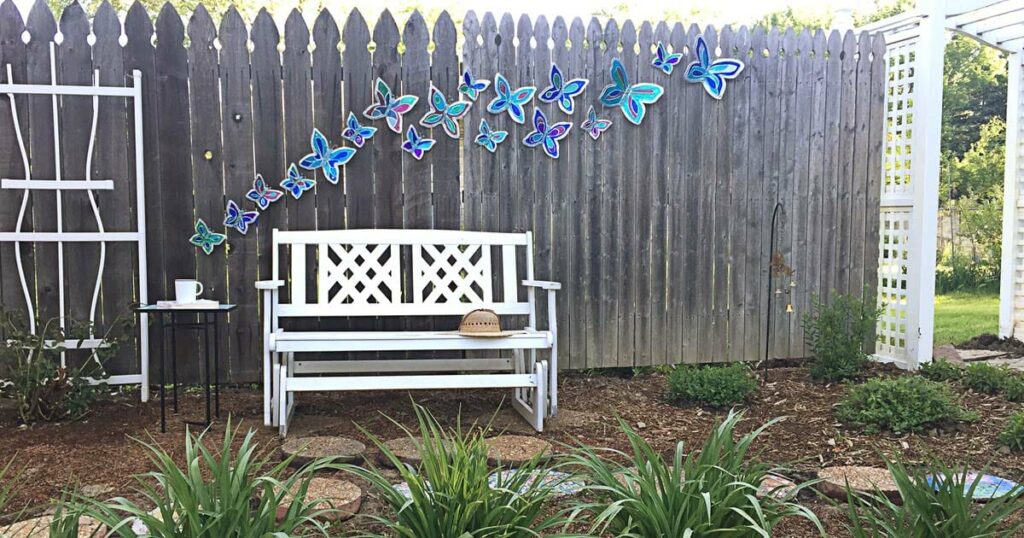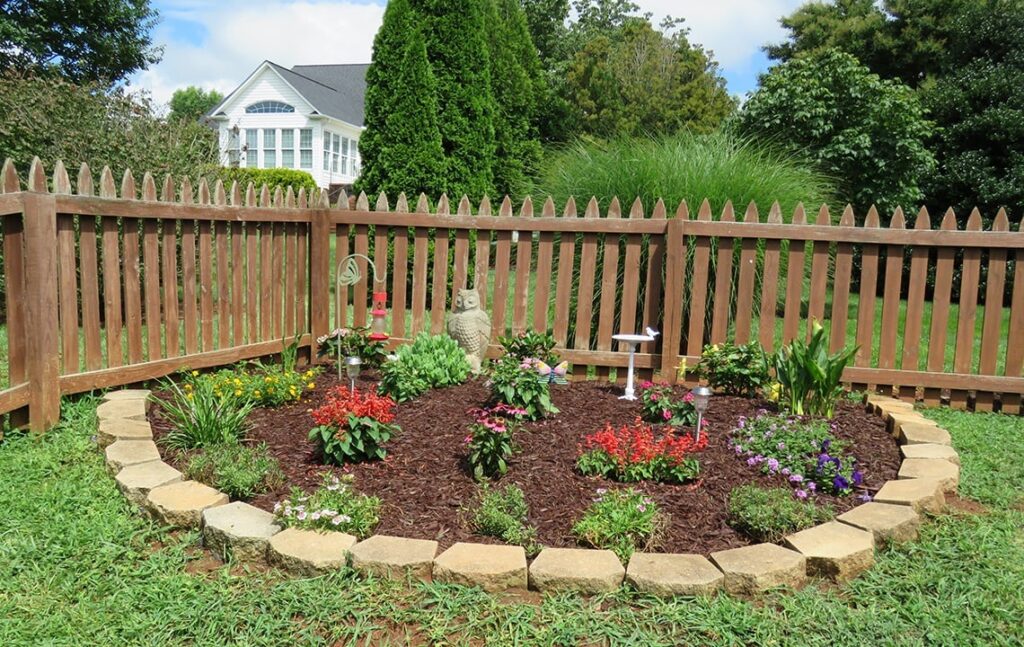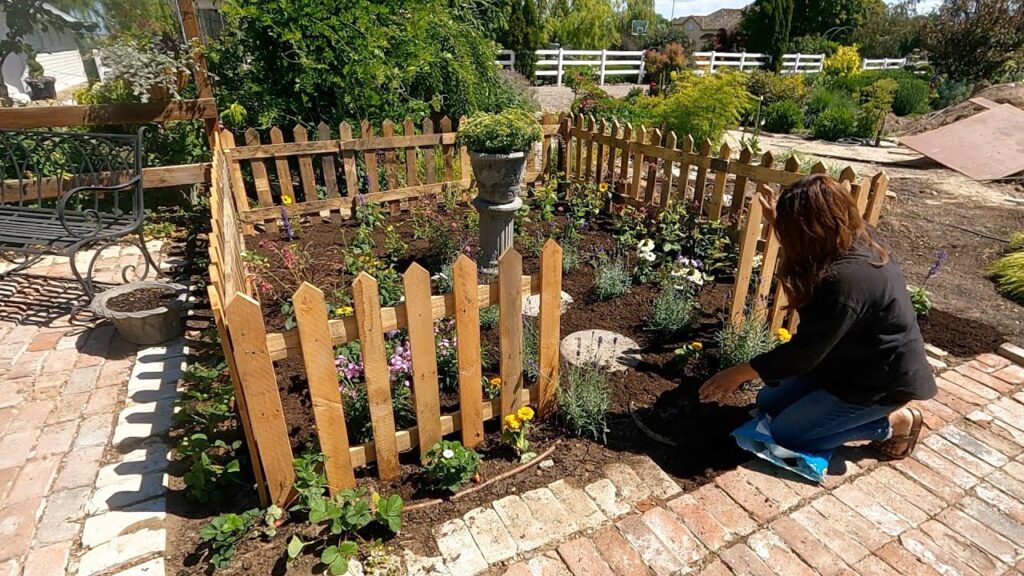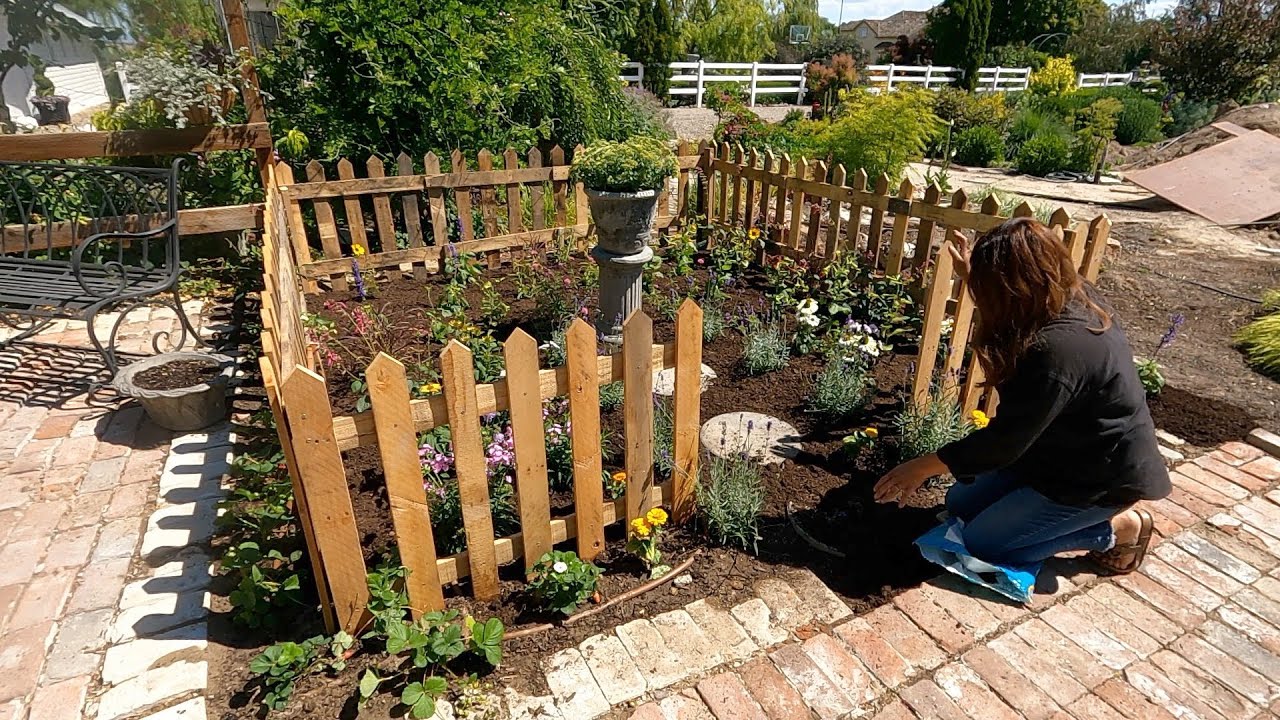Have you ever considered creating a butterfly garden with a fence? It’s a great way to attract these beautiful creatures while also adding a touch of nature to your outdoor space. In this article, we’ll explore the benefits of creating a butterfly garden with a fence and provide you with some tips on how to get started. You’ll learn about the types of flowers and plants that butterflies are attracted to, as well as the importance of choosing a fence that is both functional and aesthetically pleasing. So, let’s dive in and discover how you can create a vibrant butterfly garden right in your own backyard.
When it comes to creating a butterfly garden with a fence, there are a few key factors to consider. First and foremost, you’ll want to choose the right types of flowers and plants that will attract butterflies. Some popular options include butterfly bush, milkweed, and coneflower, which all provide nectar-rich blooms that butterflies love. It’s important to choose a variety of plants that will bloom at different times throughout the year, ensuring a continuous food source for these winged creatures. Additionally, you’ll want to select a fence that provides both functionality and beauty. A wooden fence, for example, can serve as a great backdrop for your garden while also offering privacy and protection. For those looking for a more modern touch, a metal or vinyl fence can provide a sleek and contemporary look. In our upcoming articles, we’ll explore these topics in more detail, providing you with all the information you need to create a stunning butterfly garden with a fence.
Creating a Butterfly Garden with a Fence
Creating a butterfly garden can be a rewarding experience, not only for you but for the delicate creatures that will soon call your outdoor space home. Not only will you be able to enjoy the beauty and vibrancy of butterflies, but you will also be contributing to the preservation of these important pollinators. To enhance the overall design and provide protection for your butterfly garden, consider adding a fence. In this article, we will explore the different types of fences that can be used, the benefits of having a butterfly garden, how to choose the right location, and much more.

Different Types of Fences
Before delving into the intricacies of creating a butterfly garden, it’s important to understand the different types of fences available. Each type has its own benefits and considerations, so let’s take a closer look at them.
Wooden Fences
Wooden fences are a popular choice for many homeowners due to their natural beauty and versatility. They can be customized to match any style or design preference, making them an excellent option for creating a visually appealing butterfly garden. Additionally, wooden fences offer privacy and can act as a reliable barrier to keep out unwanted pests.
Chain Link Fences
Chain link fences are more utilitarian in nature but can still be an effective choice for a butterfly garden. While they may not offer the same level of visual appeal as wooden fences, chain link fences are durable, low-maintenance, and provide excellent visibility. They allow butterflies to easily pass through while keeping larger animals out.
Vinyl Fences
Vinyl fences offer the best of both worlds – they are visually appealing like wooden fences but require minimal maintenance like chain link fences. Vinyl is a durable material that resists rotting, warping, and fading, making it an ideal choice for a long-lasting butterfly garden fence. Additionally, vinyl fences are available in a variety of colors and styles, allowing you to create a customized look for your outdoor space.
Now that we have explored the different types of fences that can be used for a butterfly garden, let’s dive into the benefits of having such a garden in the first place.
Benefits of Having a Butterfly Garden
Creating a butterfly garden goes beyond just aesthetics. These beautiful insects play a crucial role in our ecosystem as pollinators, and by providing them with a suitable habitat, you can contribute to their preservation. Here are some of the benefits of having a butterfly garden.
Enhances Biodiversity
Butterfly gardens are a fantastic way to enhance biodiversity in your yard. By planting a variety of native plants, you will attract not only butterflies but also other pollinators such as bees and hummingbirds. This helps to create a balanced ecosystem that supports a wide range of plant and animal species.
Provides Habitat for Butterflies
Butterfly populations face numerous challenges due to habitat loss and the use of pesticides. By creating a butterfly garden, you provide a safe haven for these delicate creatures to feed, rest, and reproduce. With the decline of natural habitats, they rely heavily on human-created butterfly gardens to survive and thrive.
Adds Beauty to Your Yard
One of the most obvious benefits of having a butterfly garden is the added beauty it brings to your yard. The vibrant colors of both the butterflies and the flowers create a visually pleasing environment. Imagine spending your evenings surrounded by fluttering butterflies and the sweet scent of nectar-rich flowers – it’s a sight to behold.
Now that you understand the advantages of creating a butterfly garden, let’s move on to choosing the right location for your garden.

Choosing the Right Location for a Butterfly Garden
Selecting the right location for your butterfly garden is crucial for its success. Butterflies need specific conditions to thrive, so it’s important to consider sunlight, shade, soil conditions, and space requirements. Let’s explore each of these factors in detail.
Consider Sunlight and Shade
Butterflies are cold-blooded insects and rely on the sun to warm their bodies. Therefore, it’s important to choose a location that receives ample sunlight throughout the day. Most butterfly species require at least six hours of direct sunlight to thrive. However, it’s also important to provide some shade for them to seek refuge from the scorching sun, especially during the hottest times of the day.
Evaluate Soil Conditions
Soil conditions play a crucial role in the health and growth of your butterfly garden. Butterflies prefer well-drained soil that is rich in organic matter. Before planting, assess the soil’s drainage capabilities and make any necessary amendments to ensure adequate water flow. Additionally, testing the pH levels of the soil can help you determine if any adjustments are required for certain plant species.
Ensure Sufficient Space for Growth
Butterfly gardens require a certain amount of space for plants to grow and for butterflies to move freely. Consider the size of your yard and determine how much space you can allocate for the garden. Avoid overcrowding plants, as this can hinder their growth and the overall health of the butterfly ecosystem.
Once you have chosen the perfect location for your butterfly garden, it’s time to prepare the soil.
Preparing the Soil for a Butterfly Garden
Preparing the soil is a crucial step in creating a flourishing butterfly garden. By following these steps, you can ensure that your plants have the optimal conditions for growth and provide a suitable habitat for butterflies.
Test Soil pH Levels
Before planting any flowers or plants, it’s essential to test the soil’s pH levels. Most butterflies prefer a slightly acidic to neutral pH range of 6.0 to 7.0. This information will help you choose the right plant species that thrive in the specific soil conditions of your garden. Soil testing kits can be easily purchased from garden centers or online.
Amend Soil with Compost
Adding compost to your soil is one of the best ways to improve its structure and fertility. Compost enriches the soil with essential nutrients, promotes healthy root growth, and improves moisture retention. Spread a layer of compost over the soil surface and use a garden fork or tiller to mix it thoroughly into the existing soil.
Remove Weeds and Grass
Before planting, it’s important to clear the area of any weeds or grass. These unwanted plants compete for valuable nutrients and can hinder the growth of your butterfly garden. Use a garden hoe or a weed trimmer to remove all vegetation from the area. Be sure to remove the root systems to prevent regrowth.
With the soil properly prepared, it’s time to select the right plants for your butterfly garden.

Selecting Native Plants for a Butterfly Garden
Choosing native plants for your butterfly garden is essential for attracting and supporting local butterfly populations. Native plants have adapted to the specific climate and ecosystem of your region, making them well-suited for local butterfly species. Here are some tips for selecting the right plants for your butterfly garden.
Research Native Plant Species
Research the native plant species in your area that are known to attract butterflies. Your local gardening center or native plant society can be excellent resources for finding information on the most suitable plants for your region. Take into account factors such as bloom time, flower shape, and color to create a diverse and appealing garden.
Choose Plants with Varying Bloom Times
To provide a continuous food source for butterflies throughout their active season, choose plants with varying bloom times. Some butterfly species emerge earlier in the year, while others are active later in the summer. By including early, mid, and late blooming plants, you can ensure that your butterfly garden remains attractive to these creatures all season long.
Consider Host Plants for Larvae
Butterflies have specific host plants on which they lay their eggs and that provide food for the emerging larvae, or caterpillars. Research the native plant species that serve as host plants for the butterfly species you hope to attract. By providing a suitable habitat for both adults and larvae, you can ensure a thriving butterfly population in your garden.
Once you have selected the appropriate plants, it’s time to design the layout of your butterfly garden.
Designing a Butterfly Garden Layout
Designing an aesthetically pleasing and functional layout is key to creating an inviting butterfly garden. By following these tips, you can create a visually appealing space that meets the needs of both butterflies and human visitors.
Create a Central Focal Point
Having a central focal point in your butterfly garden not only adds visual interest but also provides a place for butterflies to gather. This can be a birdbath, a strategically placed bench, or a beautifully designed flower bed. Place nectar-rich flowers around the central point to attract butterflies, and ensure there is ample space for them to land and feed.
Incorporate Different Garden Levels
Adding different levels to your butterfly garden creates more visual appeal and provides various opportunities for butterflies to rest and feed. Include taller plants and shrubs at the back of your garden to act as a natural backdrop, while shorter annuals and perennials can be placed in the front. This layered approach allows butterflies to fly at different heights and utilize the space effectively.
Include Pathways and Seating Areas
To fully enjoy your butterfly garden, don’t forget to include pathways and seating areas. This allows you to navigate through the garden easily and provides a place to sit and observe the butterflies in action. Use natural materials such as gravel or stepping stones for pathways, and consider adding a bench or some chairs for relaxation.
Now that your butterfly garden layout is complete, it’s time to focus on attracting butterflies to your garden.

Attracting Butterflies to Your Garden
To truly enjoy the presence of butterflies in your garden, it’s important to create an environment that is attractive and welcoming to them. By providing water sources, using butterfly feeders, and planting nectar-rich flowers, you can turn your garden into a butterfly haven.
Provide Water Sources
Butterflies, like all living creatures, need access to water. Consider adding a shallow dish or a birdbath to your garden, filled with fresh water. Place some small rocks or pebbles in the water to provide a landing spot for butterflies. This allows them to take a drink and refuel their energy.
Use Butterfly Feeders
Butterfly feeders can be a great supplement to nectar-rich flowers, especially during periods when flowers are scarce. You can easily make your own butterfly feeder using a shallow dish or plate filled with a mixture of sugar water. Hang it in a visible location in your garden, and watch as butterflies flock to it for a quick energy boost.
Plant Nectar-Rich Flowers
Planting flowers that are rich in nectar is crucial for attracting butterflies to your garden. Nectar serves as a food source for adult butterflies, providing them with the energy they need for flying and reproduction. Research the native plant species in your area that are known to be attractive to butterflies. Some popular choices include zinnias, coneflowers, milkweed, and bee balm. Be sure to include a variety of flower shapes, sizes, and colors to cater to different butterfly species.
As butterflies rely on nectar as their primary food source, it’s important to ensure that your garden remains a safe haven for them.
Protecting Your Butterfly Garden with a Fence
To truly enhance and protect your butterfly garden, consider adding a fence. A fence serves several purposes, including keeping out pests and creating a boundary for your garden. However, it’s crucial to choose a fence that is butterfly-friendly and complements the overall design of your garden.
Install a Fence to Keep Out Pests
Pests such as rabbits, deer, and rodents can pose a threat to your butterfly garden by eating the plants and larvae. Installing a fence around your garden acts as a barrier, keeping these unwanted visitors at bay. The type of fence you choose will depend on the specific pests in your area. For small pests, a simple wire mesh or netting fence may suffice, while larger animals may require a sturdier fence.
Choose a Fence Height Suitable for Butterflies
While a fence is necessary for protection, it’s important to choose a fence height that allows butterflies to easily pass through. Most butterfly species have a relatively low flight height, so a fence that is too high may impede their movement. A fence height of around three to four feet is generally considered suitable, as it provides a barrier to larger pests without hindering butterfly flight.
Use Butterfly-Friendly Fence Materials
When selecting materials for your fence, opt for ones that are butterfly-friendly. Avoid using chemically treated wood or harsh pesticides near the fence, as these can harm butterflies and their larvae. Instead, choose natural materials such as untreated wood, vinyl, or metal that are safe for butterflies and blend well with the overall garden design.
Once your butterfly garden fence is in place, it’s important to maintain the health and vitality of your garden.

Maintaining a Healthy Butterfly Garden
Regular maintenance is the key to keeping your butterfly garden healthy and thriving. By following these maintenance tips, you can ensure that your garden remains a welcoming haven for butterflies.
Regularly Water and Weed the Garden
Proper watering is essential for the health of your butterfly garden. Most native plants are adapted to the local climate and require less water than non-native species. Watering deeply and infrequently is recommended, as it encourages deep root growth and helps plants withstand periods of drought. Additionally, be sure to regularly weed your garden to eliminate competition for nutrients and reduce the risk of disease.
Prune Plants as Needed
Pruning is an essential part of maintaining a neat and healthy butterfly garden. Prune back any dead or damaged branches to encourage new growth and remove any diseased or infested plant parts. Additionally, some plants may require pruning to control their size and shape, allowing for optimal airflow and sunlight penetration.
Monitor for Butterfly Diseases and Pests
Butterfly gardens are not immune to diseases and pests that can affect both plants and butterflies themselves. Keep a close eye on your garden and watch for signs of disease, such as discoloration or wilting leaves. If pests are present, consider using natural, butterfly-safe methods of control such as handpicking or introducing beneficial insects.
By regular watering, pruning, and monitoring, you can quickly address any issues that may arise and maintain a healthy butterfly garden.
Educating Yourself about Butterflies
As you embark on your journey of creating a butterfly garden, take the opportunity to educate yourself about these fascinating creatures. Understanding butterfly lifecycles, identifying different species, and learning about their migration patterns can deepen your appreciation for these delicate insects.
Learn about Butterfly Lifecycles
Butterflies undergo a remarkable transformation from eggs to larvae (caterpillars), pupae (chrysalis), and finally emerge as adult butterflies. By learning about the different stages of their lifecycle, you can better understand their needs and create a more suitable habitat in your garden.
Identify Different Butterfly Species
There are numerous butterfly species around the world, each with its own unique characteristics and requirements. Familiarize yourself with the butterfly species native to your region and learn to identify them based on their size, color patterns, and flight behavior. This knowledge will allow you to cater to their specific needs and create a garden that is attractive to them.
Understand Butterfly Migration Patterns
Some butterfly species migrate over long distances, often spanning multiple generations. Research the migration patterns of butterfly species in your area to gain a deeper understanding of their behaviors and the challenges they face. By creating a butterfly garden that provides essential resources, you can contribute to their successful migration and population growth.
With your newfound knowledge about butterflies, it’s important to create a safe environment for them to flourish.
Creating a Safe Environment for Butterflies
Creating a safe environment for butterflies goes beyond providing food and shelter. By following these tips, you can ensure that your garden remains a haven for these delicate creatures.
Avoid Using Pesticides
Pesticides, insecticides, and herbicides can be harmful to butterflies, their larvae, and other beneficial insects. Avoid using these chemicals in your garden, as they can disrupt the delicate balance of the ecosystem and harm the very creatures you are trying to attract. Instead, opt for natural pest control methods such as companion planting and introducing beneficial insects.
Provide Sheltered Areas for Resting
Butterflies need sheltered areas to rest and protect themselves from harsh weather conditions. Consider including tall grasses, shrubs, or trees in your butterfly garden to provide shelter and create microhabitats. These sheltered areas also serve as excellent spots for butterflies to lay their eggs and for caterpillars to pupate.
Minimize Artificial Light at Night
Artificial light at night can be disorienting for butterflies, as they rely on natural light cues for navigation. Minimize the use of artificial lights in your garden during the night to prevent confusion and keep the natural rhythms of butterfly activities intact. If necessary, use motion-activated lights or low-intensity lighting to minimize disturbance.
Incorporating butterfly garden accessories can further enhance the beauty and whimsy of your outdoor space.
Incorporating Butterfly Garden Accessories
Butterfly garden accessories add a touch of charm and intrigue to your outdoor space while providing additional benefits for butterflies. Consider adding these accessories to further enhance your butterfly garden experience.
Add Butterfly Houses and Roosting Boxes
Butterfly houses and roosting boxes provide additional shelter and resting places for butterflies. These structures mimic natural crevices and cavities where butterflies can hide, roost, and seek refuge from predators or harsh weather. Hang them in your garden, ensuring they are positioned in a shady and protected area.
Install Butterfly Garden Markers
Butterfly garden markers not only serve as decorative accents but also help educate visitors about the different plant species and butterflies in your garden. Label each plant species with its common and scientific name, along with information about its importance to butterflies. This allows visitors to learn more about the ecosystem you have created.
Include Decorative Garden Accents
Consider including decorative accents like wind chimes, stepping stones, or colorful garden sculptures to add visual interest and whimsy to your butterfly garden. These accents can create focal points and draw attention to specific areas, creating a visually captivating space that complements the charm of butterflies.
Now that your butterfly garden is complete, it’s time to share your experience and inspire others to create their own.
Sharing Your Butterfly Garden Experience
Sharing your butterfly garden experience not only allows others to appreciate the beauty of these creatures but also creates opportunities for learning and community engagement. Here are some ideas for sharing your butterfly garden with others.
Host Garden Tours and Workshops
Invite friends, family, or even local gardening enthusiasts to your butterfly garden for tours and workshops. This allows others to learn from your experience and gain inspiration for creating their own butterfly gardens. Share your knowledge about plant selection, butterfly identification, and garden maintenance to empower others in their own gardening endeavors.
Participate in Citizen Science Projects
Citizen science projects provide opportunities for individuals to contribute to scientific research while having fun in their gardens. Join butterfly monitoring programs or butterfly population surveys to aid in data collection and help scientists better understand butterfly populations and behaviors. This collaboration can contribute to conservation efforts and butterfly preservation on a broader scale.
Share Photos and Stories on Social Media
In this digital age, social media platforms provide an excellent medium for sharing your butterfly garden experience. Upload photos of butterflies, plants, and the overall garden design to inspire others. Share your knowledge and insights through captions and stories, inviting others to engage with and learn from your journey.
Conclusion
Creating a butterfly garden with a fence can bring joy, beauty, and biodiversity to your outdoor space. By following the steps outlined in this article, you can create a haven for butterflies while also adding a decorative fence to enhance and protect the overall garden design. Enjoy the journey of creating a butterfly garden and watch as your outdoor space transforms into a flourishing ecosystem. Your efforts will contribute to the preservation of these delicate creatures and inspire others to create their own butterfly gardens. FenceDude.org wishes you every success in your butterfly garden endeavors!
